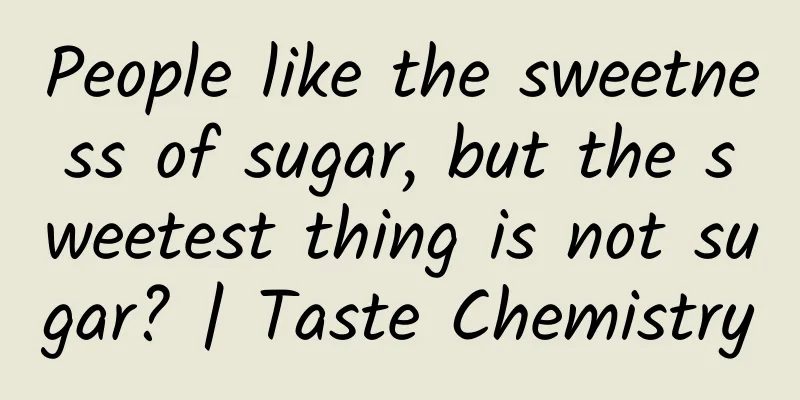People like the sweetness of sugar, but the sweetest thing is not sugar? | Taste Chemistry

|
Sweetness is a pleasant taste that makes people feel happy. Its biological essence is the interaction between sweet molecules and sweet receptors, which activate the brain reward area to release the neurotransmitter dopamine after a complex transmission process. From the perspective of chemical structure, sweet molecules can be divided into: carbohydrates (sugars, sugar derivatives, sugar alcohols, glycosides), amino acids (dipeptides, proteins), sulfonamides, etc. The sweetness value is closely related to the molecular structure. This article explains various sweet molecules and their sweetness from the molecular structure level, and see which substance is the sweetest? Written by Shi Min (Changzhou No. 1 Middle School), Jiang Xuefeng (School of Chemical Molecular Sciences and Engineering, East China Normal University) Sour, sweet, bitter, salty and umami are the five basic tastes of humans. People are born with a preference for sweetness [1]. According to Shuowen Jiezi, "Yan means beauty. Tongue means the sense of sweetness." That is, the tongue can taste sweetness. The biological mechanism of sweetness is roughly as follows: sweet molecules activate sweet receptors (T1R2/T1R3 receptors) on the taste buds of the tongue epithelium, which in turn activate G proteins and phospholipase Cβ2. The inositol triphosphate obtained by the hydrolysis of Cβ2 induces the release of intracellular Ca2+, followed by depolarization of the cell membrane and release of neurotransmitters, thereby producing sweetness [2]. At the chemical level, scientists have summarized and continuously revised and supplemented the relevant molecular structure-activity theory: (1) In 1963, Shallenberger proposed the AH-B theory, which states that sweet molecules must have both a hydrogen donor group AH (such as hydroxyl, amino, etc.) and a hydrogen acceptor group B (such as oxygen, nitrogen, etc.), and the distance between the H (hydrogen proton) of the AH group and B is 0.25-0.40 nm (Figure 1(a)). The AH-B unit of the sweet molecule interacts with the AH-B unit of the sweet receptor to produce taste [3]. (2) In 1972, Kier supplemented the AH-B theory and proposed the AH-BX triangle theory, which states that the presence of a hydrophobic group X in a molecule, and the three points AH, B, and X jointly determine the sweetness of the molecule [4] (Figure 1 (b)). The distances between X and A and B are 0.35 nm and 0.55 nm, respectively. However, later studies found that this theory does not have universal significance. (3) In 1991, Tinti further proposed the multi-site theory, which states that the sweet taste receptor has at least eight recognition points that interact with the corresponding parts of the sweet taste molecules to produce sweetness. For example, aspartame interacts with the receptor at nine sites (Figure 1 (c)) [5, 6]. It can be seen that sweetness is related to the lipid-water partition coefficient of the molecule. When the molecule reaches a lipophilic-hydrophilic balance, it interacts strongly with the sweetness receptor and has a high sweetness[7]. It is worth pointing out that the three-dimensional structure of the individual sweetness receptor and the molecule-receptor complex has not yet been obtained, so the above theory has not been fully verified and has certain limitations[8]. Figure 1 (a) AH-B theory, (b) AH-BX theory, (c) multi-point theory To date, there are more than 20 commonly used sweet molecules, such as sugars (sucrose), sugar derivatives (sucralose), sugar alcohols (sorbitol), glycosides (stevioside), dipeptides (aspartame), proteins (thaumatin), sulfonamides (saccharin), etc. The sweetness of a 5% sucrose solution at room temperature is usually set as 1, and other sweet molecules are compared with it to obtain the sweetness value. The measurement is generally based on the average value of multiple tastings by the tester, so the sweetness value is affected by subjective factors. Recently, an electronic tongue has been developed to simulate human taste and can evaluate sweetness more objectively, but the technology is not yet mature [9]. Sugar brings a sense of happiness, but excessive intake can lead to obesity and even diseases (such as diabetes). The mechanism is that excessive sugar molecules are broken down in the body to produce "rich" energy. It is estimated that by 2030, 2.16 billion people will be affected by obesity [10]. The low-calorie lifestyle has brought opportunities for the development of non-sugar sweeteners and promoted the diversified development of sweet chemistry. 01 Sugars, sugar alcohols, glycosides 1.1 Sugars and their derivatives It is generally believed that sweetness comes from sugar (also known as carbohydrates), with sucrose being the most common. Its chemical structure is attributed to two adjacent hydroxyl groups that are close in space, which satisfies the AH-B theory, with one hydroxyl group acting as AH and the oxygen atom on the other hydroxyl group acting as B (Figure 2, top). Fructose and glucose produced after the hydrolysis of sucrose also conform to the AH-B theory, with sweetness levels of 1.1~1.8 and 0.5~0.8, respectively. The sweetness of maltose, another natural sugar used in daily life, also has theoretical support. After decomposition, it produces two molecules of glucose, which comes from the hydrolysis of starch (a non-sweet polysaccharide), which is why starch tastes sweet after chewing (Figure 2, bottom). Figure 2 Common sugars and their sweetness Excessive intake of sugar can lead to pancreatic dysfunction and cause diseases such as diabetes and obesity. Therefore, scientists continue to develop substitutes for traditional sugars to satisfy people's desire for sweetness without causing significant changes in blood sugar and insulin. Some natural rare sugars have such properties [11]. Wiggers discovered trehalose in rye ergot in 1832, and Levin first used a biological method to obtain tagatose by enzymatic conversion of galactose in 1988 [12]. There is also allose produced by fructose catalytic conversion (Figure 3). Figure 3 Rare sugars and their sweetness The sweetness of natural sugar is generally concentrated around 1.0, which is difficult to meet the needs of a wider range of applications. In 1976, Hough et al. [13] found that selective replacement of some hydroxyl groups in sucrose molecules with halogens can greatly affect the sweetness of the molecule. Chlorination at position 2 even makes it bitter, while 4,1′,6′-trichlorosucrose and 4, 6,1′,4′-tetrabromosucrose have greatly enhanced sweetness (Figure 4 (a)), with sweetness levels of 400-800 and 7500, respectively. The reason is that the introduction of halogens can enhance the lipophilicity of sucrose molecules and make them more effective in interacting with sweet taste receptors; the sweetness of brominated products is higher than that of chlorinated products because the radius of the bromine atom is comparable to the molecular size on the sweet taste receptor, and the binding is more complete. Detailed studies have shown that halogenation at the 1, 4, 1′, and 4′ positions in sucrose molecules can increase sweetness [14]. Sucralose is a widely used sweet molecule. It is almost excreted from the body after consumption. It can be stored for 4 years under dry conditions at 20°C. However, it will decompose into L-glucose ketone and 5-hydroxymethylfurfural during baking. At the same time, the released hydrogen chloride will participate in the chlorination of glycerol to produce the toxic substance chloropropanol. Therefore, sucralose food should not be heated at high temperature (Figure 4 (b)) [15]. Hough used the full group protection method, including acylation, chlorination, deacylation and other steps. Although the yield was only 14.6% [16], it provided a theoretical basis for the synthesis of sucralose (Figure 4 (c)). With the increase in people's demand for sucralose and the continuous improvement of the synthesis route, the single group protection method has become a commonly used synthesis method due to its fewer steps and higher yield. After acylation, chlorination and deacylation steps, the yield can reach 27.8% [17] (Figure 4 (c)). Figure 4 (a) Sucrose halogenated derivatives, (b) transformation relationship of sucralose at high temperature, (c) synthesis route of sucralose 1.2 Sugar alcohols People have developed another series of commonly used sweet molecules - sugar alcohols, whose molecular structure is a polyol (containing multiple hydroxyl functional groups), such as sorbitol, mannitol, xylitol, etc. (Figure 5). Like sugar molecules, they are highly hydrophilic and have little interaction with sweet taste receptors, so their sweetness is not high. Sugar alcohols can be obtained from natural plants or reduced from corresponding sugars. For example, sorbitol can be obtained by reducing glucose, mannitol can be obtained by reducing mannose, and xylitol can be obtained by reducing xylose. Although sugar alcohols are not as sweet as sugar, they will not produce acid to corrode teeth under the action of oral bacteria, and can prevent tooth decay; after consumption, the blood sugar level in the human body does not rise significantly [18], so they can be consumed by diabetics, but excessive consumption can cause diarrhea. Figure 5 Common sugar alcohols and their sweetness 1.3 Glycosides Sugar sweetening molecules also include glycosides, whose molecular structure is a glycosidic bond connecting a sugar residue (the hemiacetal hydroxyl group of a monosaccharide or oligosaccharide) and a glycoside (a non-sugar part such as a hydroxyl group). Examples include stevioside, neohesperidin dihydrochalcone, and mogroside. They are natural, safe, highly sweet, and low in calories, and can prevent tooth decay[19]. Stevioside is a tetracyclic diterpene glycoside molecule that can be extracted from stevia leaves and has a sweetness of 270-300. Different numbers of glucose groups (-glu) connected to steviol (glycoside) at C-19 and different numbers and types of sugar groups connected to C-13 will result in different sweetness values [20] (Figure 6 (a)): (1) Stevioside A (sweetness 350-450) with three glucose groups connected by oxygen bonds at C-13 is sweeter than stevioside with two glucose groups; (2) When one of the three glucose groups connected to C-13 is replaced with rhamnosyl (-rhm) in stevioside C (sweetness 40-60), the sweetness is greatly reduced; (3) If C-19 is connected to stevioside E (sweetness 100~150) with two glucose groups, the sweetness will decrease slightly. The stevioside series are acid and alkali resistant, widely used in beverages, and have gradually replaced saccharin. Neohesperidin[21] is extracted from the peel of sour orange. The bitter naringin and neohesperidin (Figure 6 (b) left) are ring-opened by alkali and then hydrogenated under palladium catalysis to obtain naringin dihydrochalcone and neohesperidin dihydrochalcone[22]. The production cost is relatively high and it is often used in beverages. The relationship between the molecular structure of dihydrochalcone and the sweetness value (Figure 6 (b) right): (1) The R group connected to C-7 in dihydrochalcone is a sugar group (neohesperidosyl, abbreviated as Neo or glucosyl, etc.), and there is at least one hydroxyl group on the benzene ring connected to C-2. The molecule has a sweet taste only when these two conditions are met at the same time; (2) If C-4′ on the right benzene ring is connected to an alkoxy group, the sweetness will be enhanced. That is, the sweetness of neohesperidin dihydrochalcone (sweetness is 1000) is much higher than that of naringin dihydrochalcone (sweetness is 500~700) [23]. Mogroside V is a triterpenoid glucoside molecule that can be extracted from the Cucurbitaceae vine Momordica grosvenori, with a sweetness of 300 (Figure 6 (c)). Similar to stevioside, different numbers and types of sugar groups will result in different sweetness values, and if the hydroxyl group at the C-11 position is destroyed, it will taste bitter[24]. It is commonly used in medicines for treating dry cough, sore throat, etc. in my country[25]. It has a history of cultivation and use of 800 years, but it was not until 2004 that it was truly commercialized. Figure 6 (a) Stevioside, (b) Neohesperidin dihydrochalcone, (c) Mogroside V 02 Dipeptides, proteins Amino acids are the basic units that make up proteins. Natural amino acids that make up proteins are almost all L-type, and most of them have a bitter taste, while D-type amino acids have a sweet taste [26, 27]. The AH-BX triangle theory states that the AH-BX parts of the sweet molecule will interact with the three binding groups of the sweet receptors when they are arranged in a clockwise direction to produce sweetness. The AH-BX of D-type amino acids are arranged in a clockwise direction, while the AH-BX of L-type amino acids are arranged in a counterclockwise direction, which will produce two opposite tastes, sweet and bitter (Figure 7 (a)). 2.1 Dipeptides Dipeptide sweet molecules refer to compounds with a peptide bond between two amino acid molecules formed by dehydration condensation, such as aspartame and neotame. In 1965, James M. Schlatter accidentally obtained the sweet molecule aspartame, whose scientific name is asparagine phenylalanine methyl ester. Aspartame has a sweet taste, mainly based on the ability of the benzene ring on the molecule to produce hydrophobic interactions with the hydrophobic region of the sweet receptor. Nefro and Tinti believed that there may be two hydrophobic regions about 1 nm apart on the sweet receptor [28]. Based on this theoretical basis, an alkyl group was connected to the aspartame molecule to obtain the second hydrophobic region, and the new substance neotame was synthesized. The sweetness of aspartame is 120~200, while the sweetness of neotame is as high as 7000~13000 (Figure 7 (b)). When the number of main carbon atoms of the introduced alkyl group is three or four, and the more branches on the terminal carbon atom, the higher the hydrophobicity and the higher the sweetness [29]. In 2008, Coca-Cola Company launched a new “sugar-free” cola that uses aspartame, which is highly sweet, calorie-free, and prevents tooth decay[30]. In addition, aspartame with the same sweetness costs only 70% of sucrose, making it competitive in the sweet market. Figure 7 (a) D, L-amino acids, (b) aspartame and neotame 2.2 Proteins Plant sweet proteins refer to sweet protein macromolecules extracted from natural plants. In 1972, VanderWel et al. extracted a sweet ingredient, thaumatin, from fruit[31]. Only the sweet taste receptors of humans and monkeys can interact with it and sense its sweetness. Sweet proteins have since entered the human vision. Subsequently, scientists have isolated and purified a variety of plant sweet proteins with various sweetness levels (100-10000, Table 1). They all have the following characteristics: (1) no characteristic sequence[32]; (2) sweetness increases with the decrease of negative charge on the protein surface[33]; (3) intramolecular hydrogen bonds and hydrophobic groups affect sweetness; (4) there may be multiple binding points between sweet proteins and sweet taste receptors; (5) they are degraded into amino acids in the human body, and their absorption and utilization are not dependent on insulin. Plant sweet proteins have the characteristics of high sweetness, low calories, and the ability to prevent tooth decay[34], and can be used in the production of food, beverages, and medicines[35]. However, proteins are easily denatured at high temperatures, so foods containing sweet proteins cannot be used at high temperatures. Since the resources of fruits containing these sweet proteins are not abundant, and the transportation and extraction costs of the fruits make large-scale production difficult. Table 1 Sweet proteins and their sweetness 03 Sulfonamides Sulfonamide sweet molecules refer to a class of molecules containing sulfonamide functional groups, such as saccharin, sodium cyclamate, and acesulfame potassium, all of which were accidentally obtained by chemists. The molecules satisfy the AH-B sweetness theory (Figure 8). The sweetness of sulfonamide sweet molecules is related to the molecular volume and the volume of the substituents [36], which affect the distance between the "sweet triangles" and thus affect the sweetness. Figure 8 Sweet sulfonamide molecular structure In 1879, Russian chemist Fahlberg accidentally obtained a highly sweet molecule, saccharin, whose scientific name is o-benzoylsulfonyl imide, with a sweetness of 300-500. Fahlberg used the toluene method to synthesize it[37], while the commonly used method in my country is the independently developed phthalic anhydride method, which uses phthalic anhydride, ammonia water, liquid chlorine, sulfuric acid, sodium nitrite, copper sulfate, sulfur dioxide, etc., and undergoes processes such as amidation, Hofmann degradation, diazotization, sulfonyl chlorination, and cyclization, with a total yield of more than 80%[38] (Figure 9 (a)). Figure 9 Synthesis routes of (a) saccharin, (b) cyclamate, and (c) acesulfame potassium Saccharin is almost completely metabolized from the body 24 hours after entering the human body, and has no effect on the body; however, there are also reports that feeding high concentrations of saccharin causes cancer in mice, so it was banned in the United States in 1912, but due to the shortage of edible sugar during the World War, saccharin was used again. The Joint Committee of the World Health Organization (WHO) stipulated in 1977 that the daily allowable intake (ADI) of saccharin is 0~2.5mg/kg. my country uses saccharin sodium, which has a low production cost and an annual consumption of nearly 10,000 tons. However, due to the gradual rise of natural sweet molecules in recent years, the scale of saccharin production has shrunk. In 1937, Michael Sve-da, a student at the University of Illinois, accidentally obtained cyclamate, whose scientific name is sodium cyclohexylaminosulfonate, with a sweetness of 30-60. Its synthesis generally uses cyclohexylamine to react with aminosulfonic acid at 165°C to generate cyclohexylaminosulfonic acid. After the temperature drops below 130°C, the product is dissolved in 10% Na2CO3 solution. The yield after recrystallization can reach 97.5% [39] (Figure 9 (b)). However, it will slowly hydrolyze in the solution to produce inorganic sulfate and toxic cyclohexylamine. Usually, after human consumption, 40% is excreted through urine and 60% is excreted through feces. There is no accumulation in the body, so it is approved for use in more than 40 countries (but banned in the United States). The academic community still has no consensus on its safety [40]. In 1982, WHO stipulated that the daily allowable intake of cyclamate is 0-11 mg/kg. In 1967, German scientist K. Clauss accidentally obtained acesulfame potassium at work. Its scientific name is potassium acesulfame, and its sweetness is 130~200. Its synthesis method (Figure 9 (c)) usually adopts a strategy using aminosulfonic acid, diethylene ketone, triethylamine, and sulfur trioxide as raw materials. The reaction conditions are mild and the purity and yield (81.6%) are high37. After consumption, 100% of the original substance is excreted from the body in urine. It usually does not decompose and does not react chemically with food. The daily allowable intake is 0~15mg/kg. Mixing acesulfame potassium and aspartame is common in the food and beverage industry, which can reduce the amount of sweeteners used and improve the sweet taste. 04 in conclusion Sweetness chemistry is ubiquitous in our daily lives, and sugar compounds are the main source of energy for humans. The development of molecular structure sweetness theory not only helps people define and distinguish sweet compounds, but also provides theoretical guidance for scientists to develop new sweeteners. The definition and quantification of sweetness need to be more scientific, digital, and systematic, and the research on the structure-activity relationship of related molecules requires more extensive experimental accumulation, which will also provide a solid theoretical foundation for the development of artificial intelligence sweetness chemistry and point out the direction for the development of sweet molecules with greater application value and avoid causing diseases. With the improvement of people's living standards and the comprehensive development of related fine chemistry, sweetness chemistry will usher in a more comprehensive scientific and industrial leap. References [1] Maone TR, Mattes RD, Bernbaum JC, etal. Dev. Psy-chobiol., 1990, 23 (2): 179-191 [2] Fang Longmei, Du Peng, Mu Huiling, et al. Chemistry of Life, 2019, 39 (2): 289-296 [3] Shallenberger RS, Acree T E. Nature, 1967, 216: 480-482 [4] Zheng Jianxian. High-efficiency sweeteners. Beijing: China Light Industry Press, 2009: 1-20 [5] Ellis J WJ Chem. Educ., 1995, 72 (8): 671-675 [6] Liu Xiaodan. Food Science and Technology, 2019(7): 107-110 [7] Walters D EJ Chem. Educ., 1995, 72 (8): 680-683 [8] Giulia S, Antonella DP, Pietro C. Trends Food Sci. Tech., 2020, 96: 21-29 [9] Pang Guangchang, Chen Qingsen, et al. Food Science, 2017, 38 (5): 288-298 [10] Kelly T, Yang W, Chen CS, et al. Int. J. Obesity, 2008, 32(9):1431-1437 [11] Espinosa I, Fogelfeld L. Expert Opin. Investig. Drugs, 2010,19 (2): 285-294 [12] Levin GJ Med. Food, 2002, 5(1): 23-36 [13] Hough L, Phadnis S P. Nature, 1976, 263: 800 [14] Shallenberger R S. Food Technol., 1998, 52: 72-76 [15] Rahn A, Yaylayan V A. Food Chem., 2010, 118: 56-61 [16] Hough L, Phadnis SP, Khan R A. Sweeteners: British, GB1543167A. 1976-01-08 [17] Leng Yixin, Zhang Zhao, Huang Chunxiang, et al. Chemical Research and Application, 2011, 23(12): 1666-1670 [18] Zheng Jianxian. China Food Additives, 2001(5): 32-36 [19] Carrera-Lanestosa A, Moguel-Ordonez Y, Segura-Campos MJ Med. Food, 2017, 20 (10): 933-943 [20] Wang Deji. Chinese Food Additives, 2007(3): 46-53. [21] Robertson GH, Clark JP, Lundin R. Ind. Eng. Chem. Prod. Res. Dev., 1974,13 (2): 125-129 [22] Qiao Xin, Liu Xi, Yang Jun, et al. Chinese Journal of Food Additives, 2019, 30 (3): 51-58 [23] Yang Jinhui, Meng Licong. Ningxia Engineering Technology, 2007, 6 (1): 43-46 [24] Wang L, Yang Z, Lu F, et al. Molecules, 2014, 19 (8): 12676-12689 [25] DuBois GE, Prakash I. Annu. Rev. Food Sci. Technol., 2012, 3: 353-380 [26] Bachmanov AA, Bosak NP, Glendinning J I. Adv. In Nutrition, 2016, 7(4): 806-822 [27] Zeng Guangzhi. Chemical Bulletin, 1998 (8): 1-9 [28] Nofre C, Tinti J M. N-substituted derivatives of aspartame useful as sweetening agents: USA, US5480668. 1996-01-02 [29] Qiu Jie, Zheng Jianxian. Food Industry, 2007 (5): 15-17 [30] Chattopadhyay S, Raychaudhuri U, Chakraborty RJ Food Sci. Tech., 2014,51 (4): 611-621 [31] Vander Wel H, Loeve K. Eur. J. Biochem., 1972, 31: 221-225 [32] Liu Qiulei. Chemistry of Life, 2014, 34 (4): 500-505 [33] Weifeng X, Szczepankiewicz O, Thulin E, et al. BBA-Proteins Proteom., 2009, 3: 410-420 [34] Kant R. Nutr. J., 2005,4 (5): 1-6 [35] Lü Zhenyue, Zhou Damin, Huang Dongdong. Progress in Bioengineering, 2002 (1): 64-67 [36] Yamazaki T, Benedetti E, Kent D, et al. Angew. Chem. Int. Ed., 1994,33 (14): 1437-1451 [37] Ma Shuyi, Zhao Tonglin, Dong Shiliang, et al. Journal of Henan University of Technology, 2013, 34(5): 109-118 [38] Li Meiju, Pu Shuaitian, Zhang Wanqing, et al. Guangdong Chemical Industry, 2007, 34 (1): 70-72 [39] Kuang Shenglu. Modern fine chemical high-tech and product synthesis process. Beijing: Science and Technology Literature Press, 1997, 12: 584 [40] Bopp BA, Sonders RC, Kesterson J W. Crit. Rev. Toxicol., 1986, 16: 213-306 This article was originally published in the 16th issue of "Chemical Education" in 2020. The original title was "Sweetness Chemistry of Taste Chemistry" and was authorized by the author to be published in "Fanpu". |
<<: What are the precautions before and after vaccination? Parents, please pay attention
>>: What kind of place is Zhangjiajie? What are the intangible cultural heritages of Zhangjiajie?
Recommend
What is wrong with irregular menstruation?
It is common for female friends to experience irr...
What are the sequelae of cesarean section
Nowadays, many people emphasize that natural birt...
How many days does it take for mastitis to heal?
We all know that mastitis can be divided into sub...
Why does menstruation come early after taking birth control pills?
Now many people born in the 1980s have reached th...
Can I eat cakes during my period?
Menstruation refers to the shedding of the endome...
What should I do if I get freckles during pregnancy?
Most people call stretch marks chloasma, butterfl...
I drank corn silk for so long, but it was all in vain!
As winter approaches, the weather changes signifi...
Popular Science | Abdominal massage can prevent constipation, are you doing it right?
Constipation is one of the most common complicati...
Does breast augmentation with implants affect breastfeeding?
Many women may feel dissatisfied with their breas...
The whole process of fallopian tube iodine water angiography
Fallopian tube disease is a common gynecological ...
Social Seat Selection expands to hotels, rail and events
More than a year ago, KLM unveiled its Meet &...
What are the white labia minora?
The structure of the female labia minora is quite...
Does the nine-price thing hurt?
The nine-valent HPV vaccine mainly prevents infec...
Early symptoms of postpartum infection
Pregnant women have symptoms of puerperal infecti...









